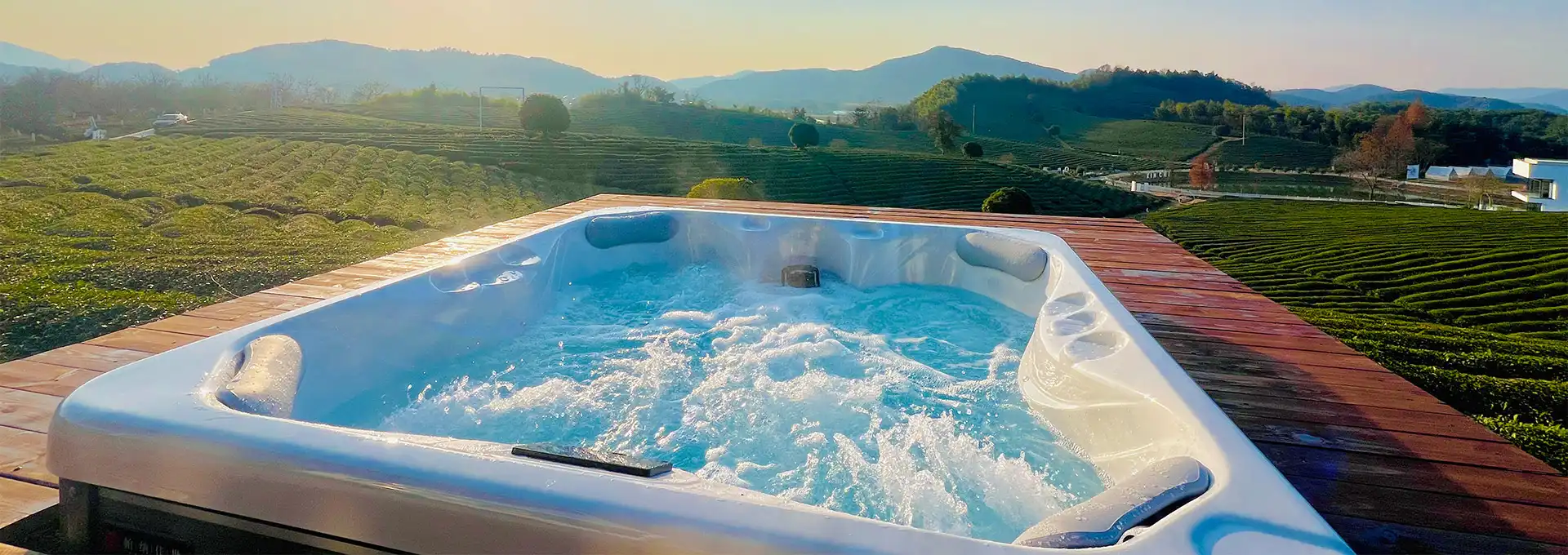Can I Empty Hot Tub on Grass?
2024-11-16 15:53:01
Draining a hot tub is a necessary maintenance task that every spa owner must face periodically. When it comes time to empty your hot tub, you might wonder if it's safe to drain the water onto your lawn. This question is common among homeowners who want to maintain their landscaping while also properly caring for their hot tub. In this article, we'll explore the implications of emptying your hot tub on grass and provide guidance on the best practices for draining your spa.
How often should I drain my hot tub?
Regular draining and refilling of your hot tub is essential for maintaining water quality and ensuring the longevity of your spa equipment. The frequency at which you should drain your hot tub depends on several factors, including usage, water quality, and maintenance practices. As a general rule of thumb, most hot tub manufacturers recommend draining and refilling your spa every 3-4 months.
However, this timeline can vary based on how often you use your hot tub and how well you maintain it. If you're a frequent user or if you notice issues with water clarity or balance, you may need to drain your hot tub more often. On the other hand, if you use your spa less frequently and maintain proper chemical balance, you might be able to extend the time between drains.
To determine if it's time to drain your hot tub, consider the following indicators:
- Cloudy or foamy water that doesn't clear up with proper chemical treatment
- Difficulty maintaining proper pH and sanitizer levels
- Unpleasant odors coming from the water
- Visible algae growth or biofilm formation
- A significant increase in total dissolved solids (TDS) levels
Regular draining not only helps maintain water quality but also provides an opportunity to clean and inspect your hot tub components. This preventive maintenance can help identify potential issues before they become major problems, saving you time and money in the long run.
When draining your hot tub, it's important to follow the manufacturer's instructions and local regulations regarding water disposal. While some areas may allow draining onto grass or landscaping, others may require you to drain into a sanitary sewer system. Always check with your local authorities to ensure compliance with water disposal regulations in your area.
What are the effects of hot tub water on grass?
The effects of hot tub water on grass can vary depending on several factors, including the chemical composition of the water, the type of grass, and the overall health of your lawn. While some homeowners may be tempted to use hot tub water as a way to irrigate their lawn, it's important to understand the potential consequences before emptying your spa onto the grass.
One of the primary concerns when draining hot tub water onto grass is the high concentration of chemicals typically found in spa water. Hot tubs require regular treatment with sanitizers, such as chlorine or bromine, as well as pH balancers and other water care products. These chemicals, while necessary for maintaining a safe and clean hot tub environment, can be harmful to your lawn when applied in large quantities.
The effects of hot tub water on grass may include:
- Chemical burn: High levels of chlorine or bromine can cause chemical burns on grass blades, leading to yellowing or browning of the affected areas.
- Salt damage: If you use a salt water system in your hot tub, the high salt content can be detrimental to grass and soil health.
- pH imbalance: Hot tub water often has a different pH level than what's ideal for grass growth, potentially affecting soil chemistry and nutrient availability.
- Overwatering: Draining a large volume of water in one area can lead to oversaturation of the soil, potentially causing root rot or other water-related issues for your grass.
- Temperature shock: Hot water can damage grass roots, especially if the temperature difference between the water and the soil is significant.
However, it's worth noting that the effects of hot tub water on grass are not always negative. In some cases, if the chemical levels are properly balanced and the water is allowed to cool before draining, the additional moisture can be beneficial to your lawn, especially during dry periods. The key is to ensure that the water is safe for your grass and to distribute it evenly across a large area rather than concentrating it in one spot.
If you do decide to drain your hot tub onto your lawn, consider the following tips to minimize potential damage:
- Test the water chemistry and adjust it to be as neutral as possible before draining.
- Allow the water to cool to ambient temperature before emptying it onto the grass.
- Use a long hose to distribute the water over a larger area, avoiding pooling in any one spot.
- Avoid draining onto areas with sensitive plants or newly seeded grass.
- Water the area thoroughly with fresh water after draining to help dilute any remaining chemicals.
By taking these precautions, you can reduce the risk of damaging your lawn while still making use of the water from your hot tub.
Are there alternative ways to dispose of hot tub water?
While draining hot tub water onto grass may seem like a convenient option, there are several alternative methods for disposing of spa water that may be more environmentally friendly and compliant with local regulations. Exploring these alternatives can help you maintain your hot tub responsibly while protecting your landscaping and the surrounding ecosystem.
Here are some alternative ways to dispose of hot tub water:
- Sanitary Sewer System: In many areas, the preferred method for disposing of hot tub water is to drain it into the sanitary sewer system. This typically involves connecting a hose to your hot tub's drain valve and routing it to a utility sink, floor drain, or cleanout pipe. Before using this method, check with your local water authority to ensure it's allowed and to learn about any specific requirements or restrictions.
- Storm Drain: Some municipalities allow hot tub water to be drained into storm drains, which lead to local waterways. However, this option is becoming less common due to environmental concerns. If you're considering this method, it's crucial to check local regulations and ensure that your hot tub water is properly deoxygenated and free of harmful chemicals before draining.
- Irrigation: If your hot tub water is properly balanced and free of excess chemicals, you may be able to use it for irrigation purposes. Instead of emptying it directly onto your lawn, consider using the water for trees, shrubs, or other landscaping elements that are more tolerant of varied water conditions. Be sure to distribute the water evenly and avoid oversaturating any one area.
- Natural Areas: Some homeowners choose to drain their hot tub water into natural areas on their property, such as wooded areas or fields. While this can be an option in some cases, it's important to ensure that the water won't negatively impact local flora and fauna or contribute to erosion issues.
- Professional Disposal: If you're unsure about the best way to dispose of your hot tub water or if local regulations are particularly strict, consider hiring a professional water disposal service. These companies have the equipment and expertise to remove and dispose of your spa water safely and in compliance with local laws.
When choosing an alternative disposal method, consider the following factors:
- Local regulations: Always check with your municipal water authority or environmental agency to understand the specific rules governing hot tub water disposal in your area.
- Environmental impact: Consider the potential effects of your chosen disposal method on local ecosystems, groundwater, and wildlife.
- Water quality: Ensure that your hot tub water is properly balanced and free of excessive chemicals before disposal, regardless of the method you choose.
- Volume of water: Take into account the amount of water you need to dispose of and choose a method that can handle that volume without causing issues.
- Frequency of draining: If you drain your hot tub frequently, it may be worth investing in a more permanent solution, such as a dedicated drainage system.
By carefully considering these alternatives and factors, you can find a safe and responsible way to dispose of your hot tub water without relying solely on draining it onto your grass. This approach not only helps protect your lawn but also ensures that you're being a good steward of the environment and complying with local regulations.
Conclusion
In conclusion, while it is possible to empty a hot tub on grass, it's not always the best option due to potential negative effects on your lawn and local ecosystems. The high concentration of chemicals, salt content, and temperature of hot tub water can potentially damage grass and soil health. However, if done carefully and with proper precautions, draining onto grass can be a viable option in some cases.
It's crucial to consider alternative disposal methods, such as using the sanitary sewer system, storm drains (where allowed), or professional disposal services. Always check local regulations and consider the environmental impact of your chosen disposal method. By maintaining proper water chemistry, following manufacturer guidelines for draining frequency, and disposing of hot tub water responsibly, you can enjoy your spa while minimizing its impact on your landscaping and the environment.
For more information on hot tub installations and our products, please feel free to contact us at info@iparnassus.com.
References
- Environmental Protection Agency. (2021). Recreational Water and Beaches.
- American Society of Landscape Architects. (2020). Sustainable Residential Design: Improving Water Efficiency.
- National Association of Landscape Professionals. (2021). Best Practices for Water Conservation in Landscaping.
- Water Quality Association. (2021). Water Treatment for Dummies.
- Centers for Disease Control and Prevention. (2021). Healthy Swimming/Recreational Water.
- Association of Pool & Spa Professionals. (2020). Hot Tub Maintenance and Care Guide.
- Journal of Environmental Management. (2019). Effects of chlorinated water on soil and plants.
- Horticulture Magazine. (2021). Understanding Soil pH and Nutrient Availability.
- Turf Magazine. (2020). The Impact of Water Quality on Turfgrass Health.
- International Journal of Environmental Research and Public Health. (2018). Recreational Water Quality and Human Health.



